Exercises (1559)
Squat and lunge alternating in jump (alternating jump) ► squat & jumping lunge
Power
Individual work
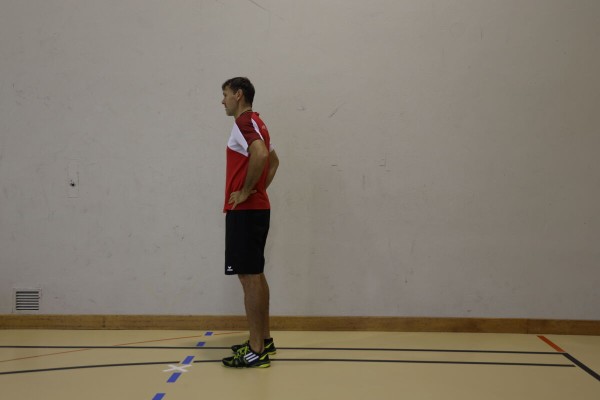
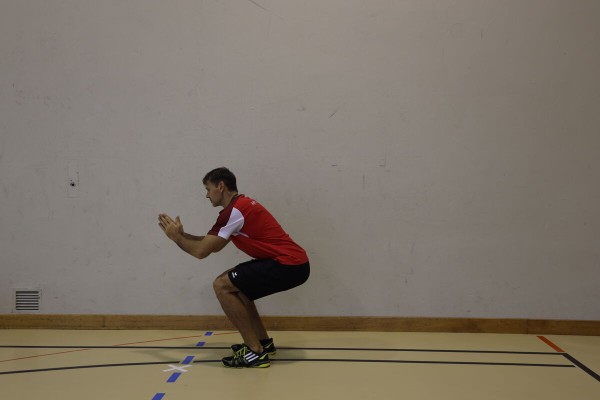
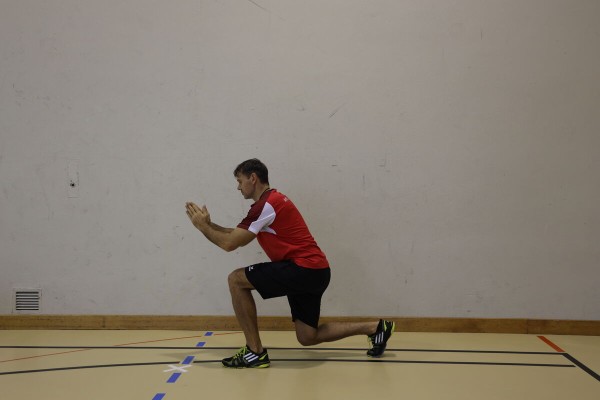
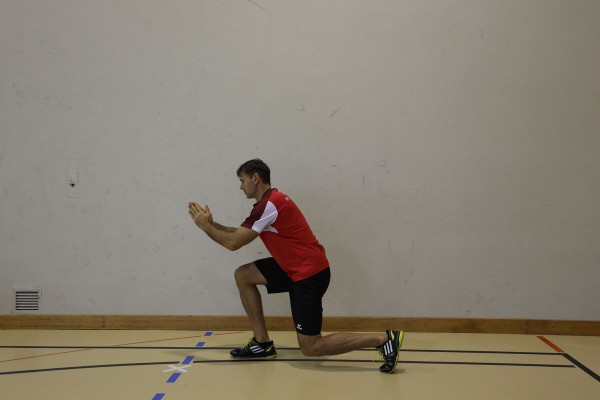
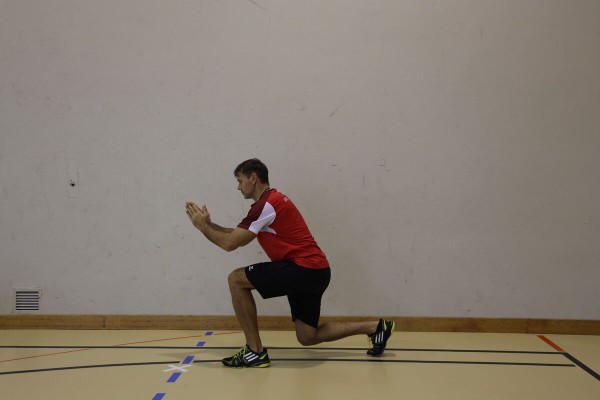
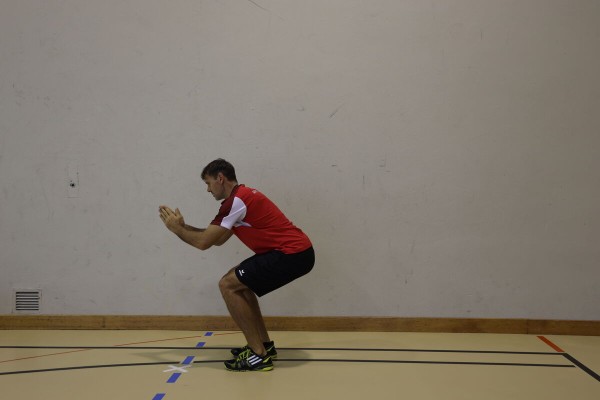
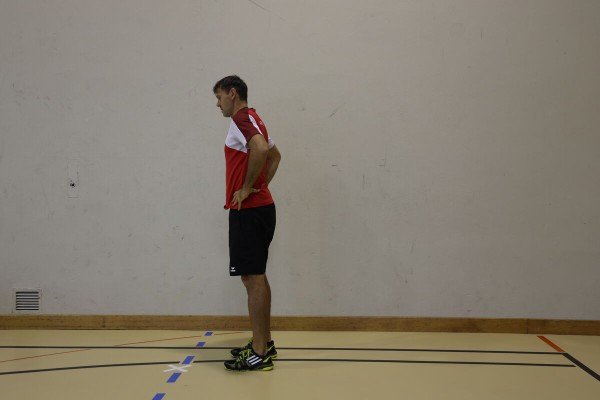
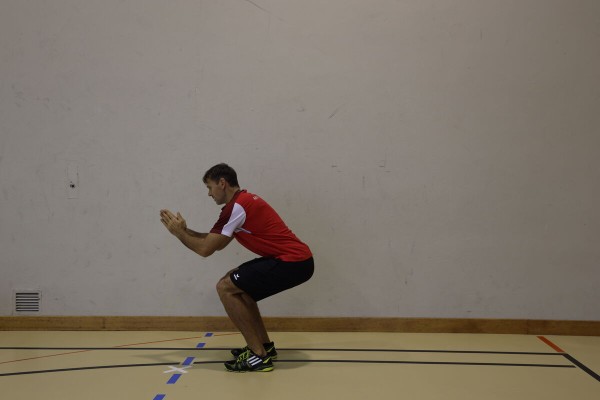
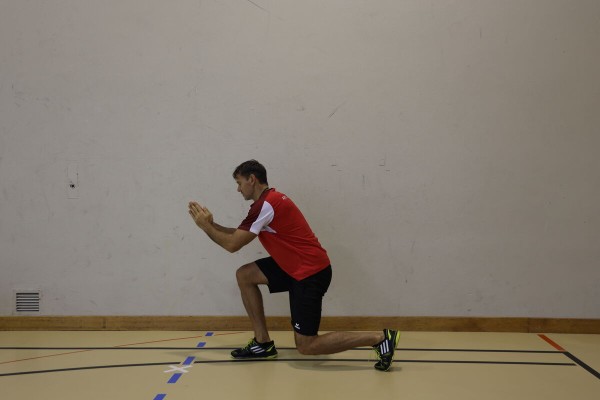
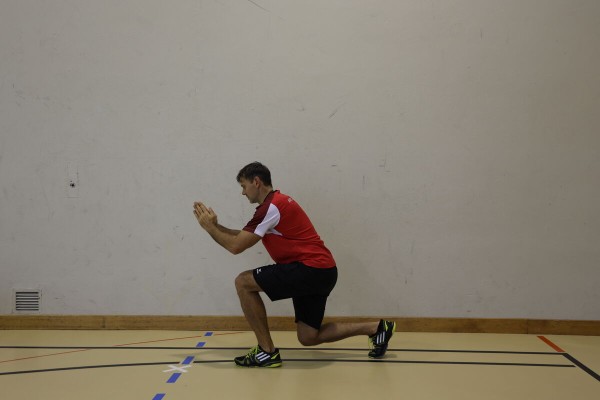
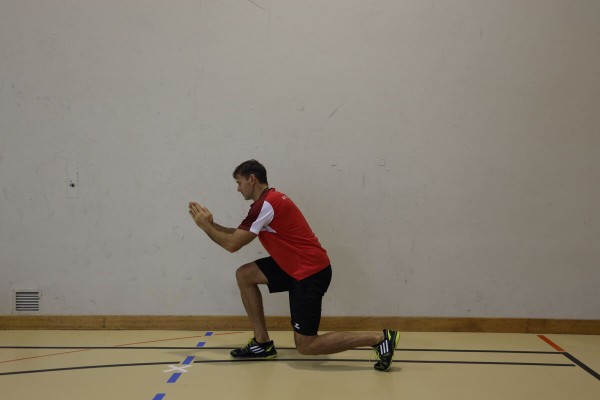
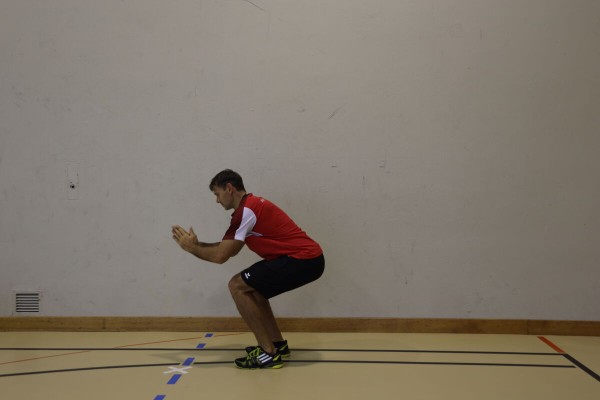
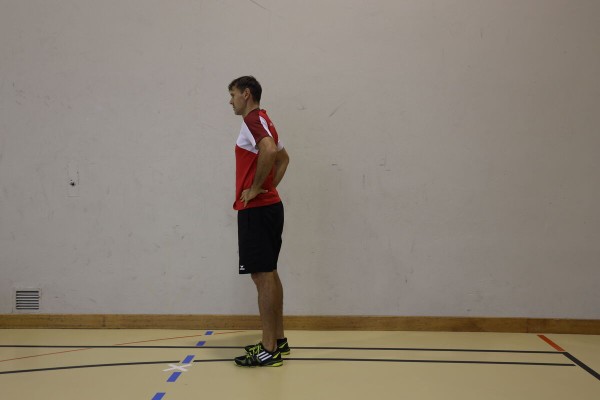
Stand with your feet shoulder-width apart, arms supported on your hips, bent or in front of you at chest height, bend your knees to approximately a right angle at the knee joints (buttocks at about knee height). From the deep squat position, perform a lunge backwards (upper body upright, abdomen tensed), arms again supported on the hips, folded on the chest, bent in front or at an angle, front (and back) leg bent to a right angle, two-legged jump to change leg position during the jump (move back leg forwards and front leg backwards - body position remains low), new alternating jump to return to the starting position in the lunge. Move the back leg forwards to the deep squat position before stretching the legs back to the starting position in a shoulder-width stance. After the new squat, change the side of the lunge compared to the previous version.
Attention:
When squatting, move your buttocks backwards, not your knees forwards. Keep your knees behind your toes. Keep your back straight at all times (tense your core), distribute your weight over your entire foot, push your knees outwards (do not tilt them inwards). When lunging, always keep the front knee behind the toe and centred over the foot. Keep your upper body as stable as possible.
Lighten:
Do not lower your buttocks too low (greater angle in the knees) when squatting. Higher basic position/lower upper body less (greater angle at the knees) when doing lunges.
Harden:
Additional weight (on the shoulders, with hanging arms or in a forward or upright position).
Variation:
Jump height can be varied: high jumps with plenty of time to change leg position or only small jumps with quick leg shifts.
1 weight vest/weight disc/(medicine) ball/sandbag/fighting backpack/2 dumbbells ► Make the exercise more difficult (additional weight)
Squat and straddle jump alternating ► sumo squat jump
Power
Individual work
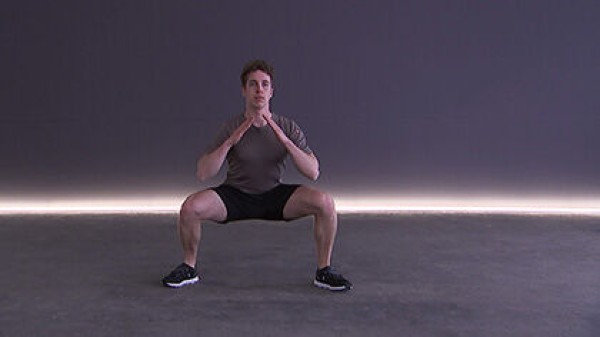
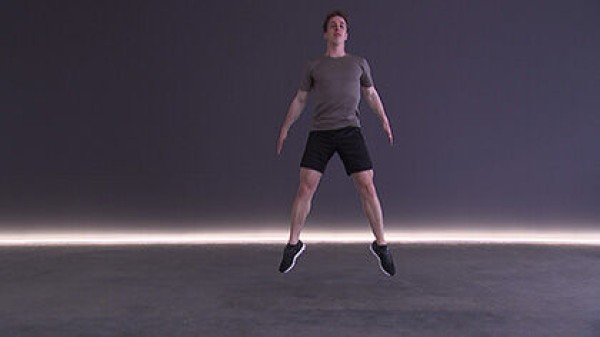
Stand with your feet shoulder-width apart, bend your knees to approximately a right angle at the knee joints (buttocks at about knee height), arms supported on your hips, folded across your chest, bent or in front of you at chest height, jump up and simultaneously spread and stretch your legs (straddle jump), cushion the jump (bend your knees slightly) and return to the starting position.
Attention:
Bring your buttocks back, not your knees forwards. Keep your knees behind your toes. Keep your back straight at all times.
Lighten:
Do not lower your buttocks too low (larger angle in the knees), smaller/less intense/higher jumps.
Harden:
Hold additional weight (on your shoulders, in front of you or with your arms hanging in your hands); larger, more intense/higher jumps.
2-4 weight vest/1 (medicine) ball/weight disc/sandbag/1-2 dumbbells ► Make the exercise more difficult (additional weight)
Knee bend and body extension alternating
Power
Individual work
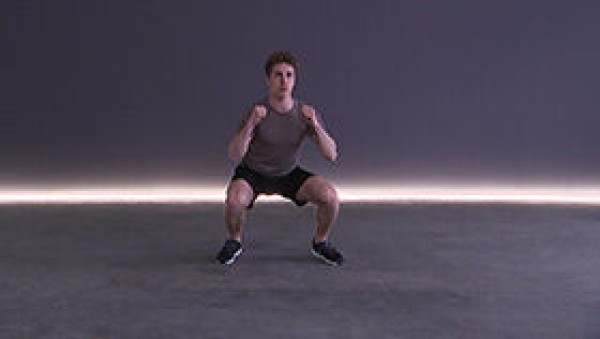
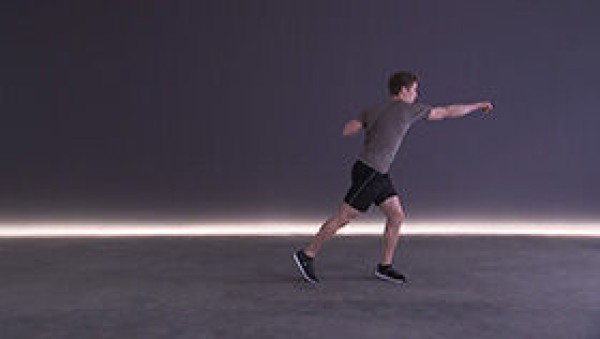

Stand with your feet shoulder-width apart, arms bent in front of your body (hands at chest height), bend your knees to a right angle at the knee joints (buttocks at knee height, deep squat), stretch one arm overhead at the same time as you stretch your legs (slightly crosswise, hand approximately at the height of the opposite shoulder), squat down again and stretch the other arm upwards with the next body stretch.
Attention:
Move your buttocks backwards, not your knees forwards. Keep your knees behind your toes. Keep your back straight at all times.
Lighten:
Do not lower your body too low (greater angle in the knees).
Harden:
Additional weight (hold on the arms or in the hands).
2 weight cuffs/weight balls/dumbbells/1 weight waistcoat ► Make the exercise more difficult (additional weight)
Squat and jump onto an object alternately ► squat jump
Power
Individual work
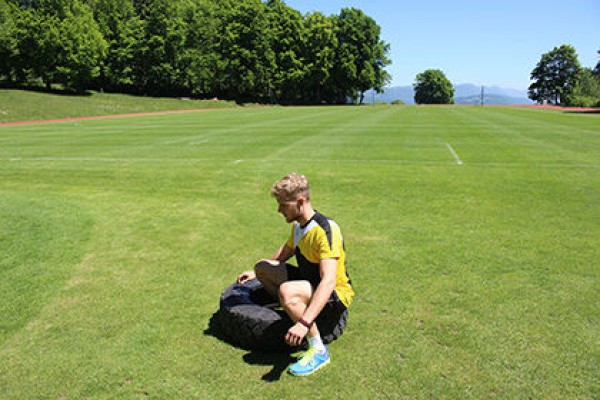
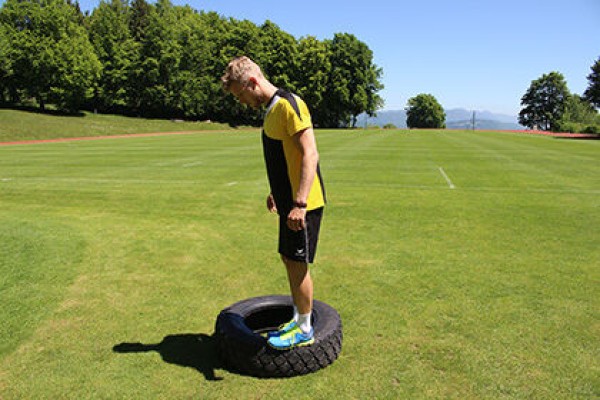
Sit on an object lying on the floor (e.g. tyre - both legs inside or one leg inside and one leg outside the tyre), jump off with both legs to stand on the object, jump back to the starting position in the seat.
Attention:
Upright upper body, do not put all your weight down, keep your knees behind the tips of your feet.
Lighten:
Jump straight up from the seat without landing on the object in between (sit with both legs outside the tyre); lower your buttocks less (do not touch the object); lower cadence.
Harden:
Jump up after standing on the object with a direct landing on the seat; additional weight (on the shoulders); higher cadence.
1 tyre (10DM)
1 weight vest/sandbag/fighting rucksack ► to make the exercise more difficult (additional weight)
Squat and jump onto an object alternately ► squat jump
Power
Individual work
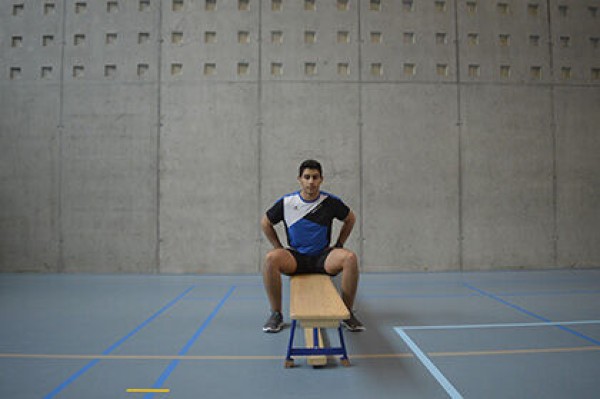
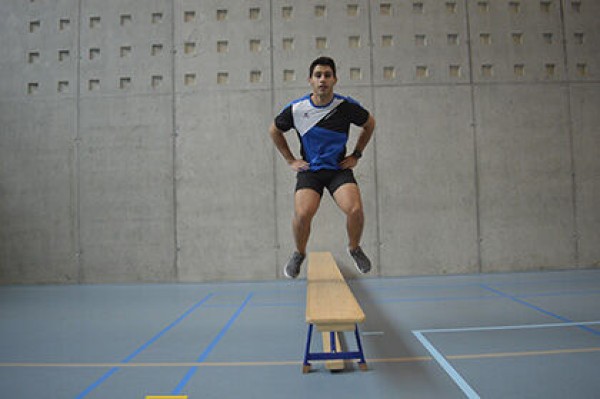
Sit on the long bench (one leg on each side of the bench), arms supported on the hips or in front, jump off with both legs to stand on the long bench, jump back to the starting position in the seat.
Attention:
Upright upper body, do not put all your weight down, keep your knees behind the tips of your feet.
Lighten:
Sit with both legs on the same side of the bench, only jump straight up from the seat without landing on the long bench in between; lower your buttocks less (do not touch the long bench); lower cadence.
Harden:
After standing on the long bench, jump up with a direct landing to the seat; choose a higher element (squat less intense, but jump up more difficult); additional weight (on the shoulders); higher cadence.
1 long bench
2 vaulting box elements (incl. top section) ► Make the exercise more difficult (position)
2 weight cuffs/1 weight vest/sandbag ► Make the exercise more difficult (additional weight)
Squat and stretch jump alternating ► squat jump
Power
Individual work
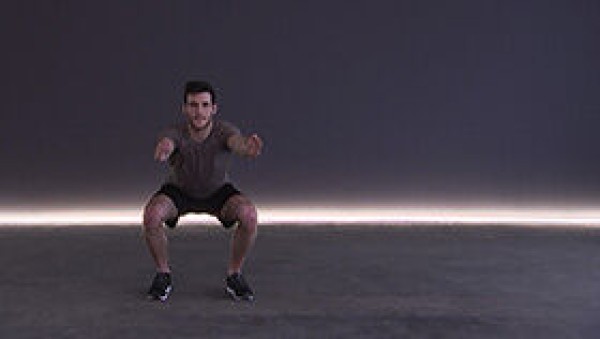
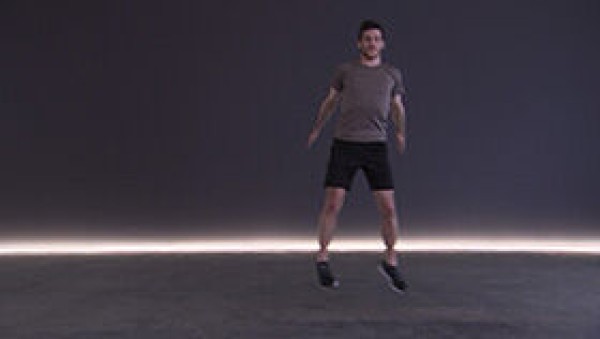
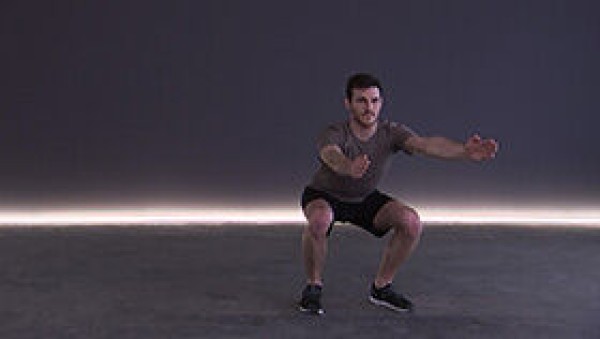
Stand with your feet shoulder-width apart, bend your knees to approximately a right angle at the knee joints (buttocks approximately at knee height), arms supported on your hips, folded across your chest or in front of you at chest height, jump up slightly, cushion the jump (bend your knees slightly) and return to the starting position.
Attention:
Bring your buttocks back, not your knees forwards. Keep your knees behind your toes. Keep your back straight at all times.
Lighten:
Do not lower your buttocks too low (larger angle in the knees), smaller/less intense/higher jumps.
Harden:
Hold additional weight (on your shoulders, in front of you or with your arms hanging in your hands); larger, more intense/higher jumps.
1 weight vest/(medicine) ball/weight disc/sandbag/1-2 dumbbells ► Make the exercise more difficult (additional weight)
Squat and stretch jump alternating ► squat jump
Power
Individual work
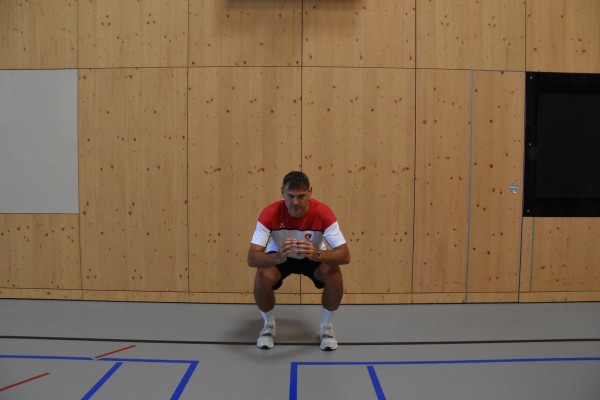
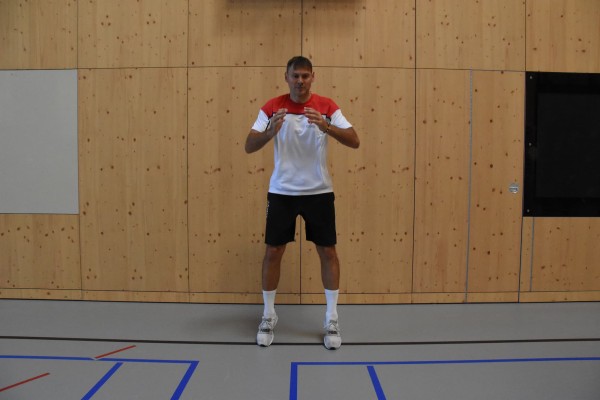
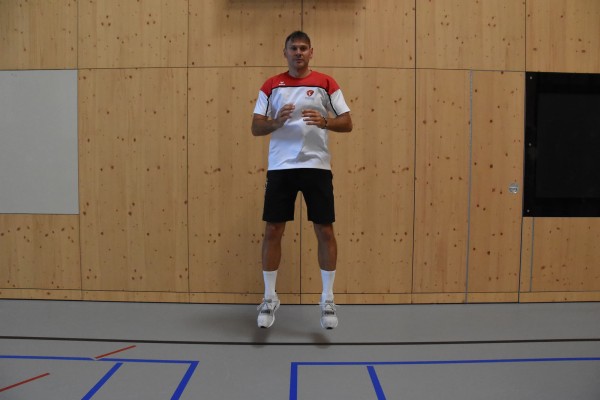
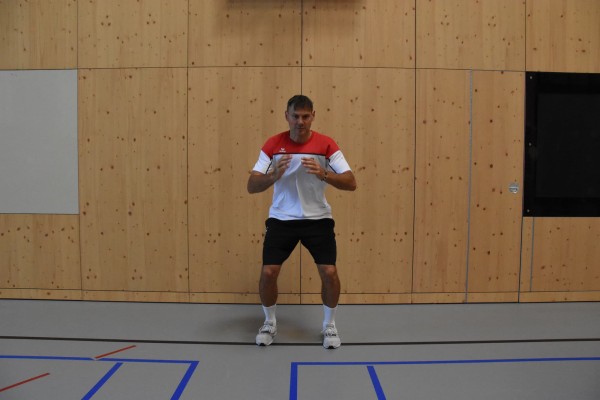
Stand shoulder-width apart, bend your knees almost to a right angle at the knee joints (buttocks slightly above knee height), arms supported on your hips, folded across your chest or in front of you at chest height (possibly with bent arms including hands), jump upwards, cushion the jump and return to the starting position. Repeat the sequence of movements continuously.
Attention:
Bring your buttocks back, not your knees forwards. Keep your knees behind your toes.
Lighten:
Do not lower your buttocks too low (larger angle in the knees), smaller/less intense/higher jumps.
Harden:
Hold additional weight (on your shoulders, in front of you or with your arms hanging in your hands); larger, more intense/higher jumps.
1 weight vest/(medicine) ball/weight disc/sandbag/1-2 dumbbells ► Make the exercise more difficult (additional weight)
Kneeling position and jumping onto an object ► kneeling position & box jump
Power
Individual work
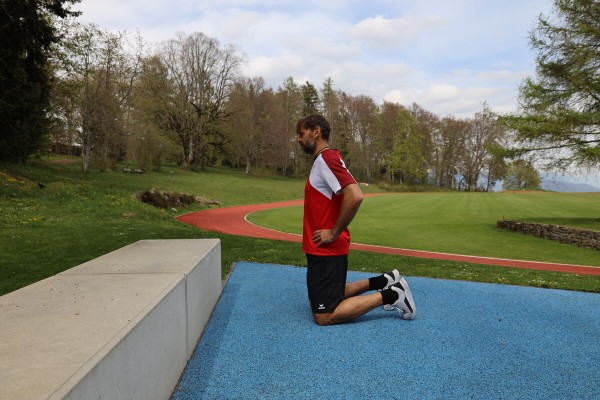
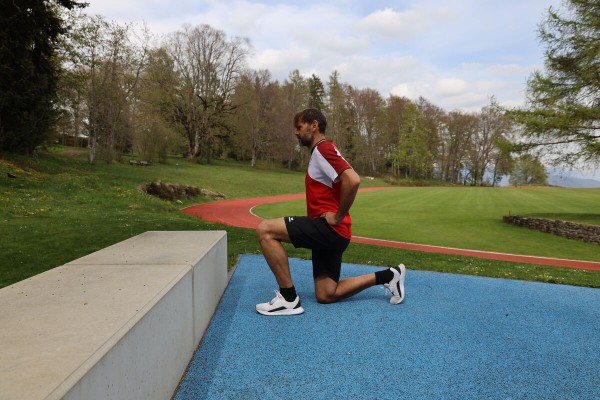
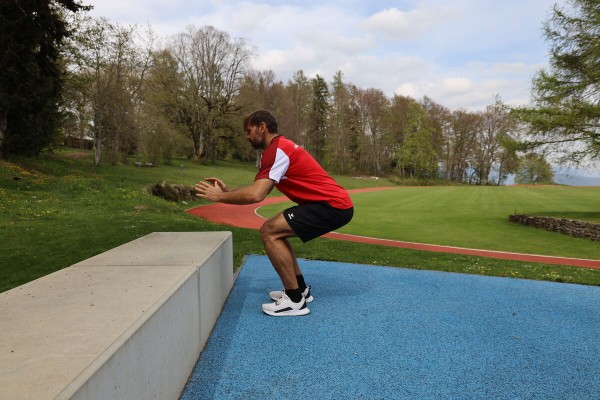
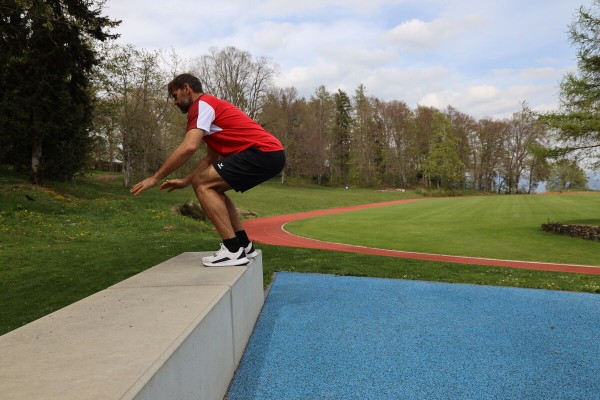
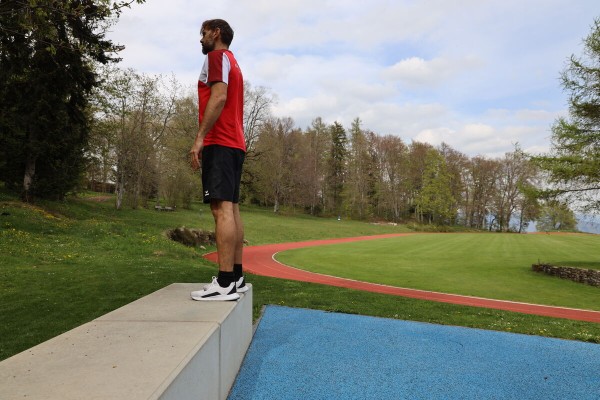
Stand on one knee, alternate between standing on one leg and assuming a deep squat position. From the squat position, tilt your upper body slightly forwards, stretch your arms backwards at an angle to your body (like a ski jumper on a ski jump), push off the floor powerfully to perform a jump onto a raised object (plyo box or swinging box element incl. top) (use the momentum of the arms), straighten your upper body (stand on the object) and jump back to the starting position (possibly the other side of the object), then return to the kneeling position. Change the starting leg with each execution.
Attention:
Land as softly as possible (cushion the jump with your knees).
Lighten:
Lower intensity between each execution; lower the height of the object.
Harden:
Additional weight; higher object.
1 flat bench/plyo box/swivel box
2-4 weight cuffs/1 weight waistcoat ► Make the exercise more difficult (additional weight)
Headstand to support ► tripod to plank kip
Power
Individual work

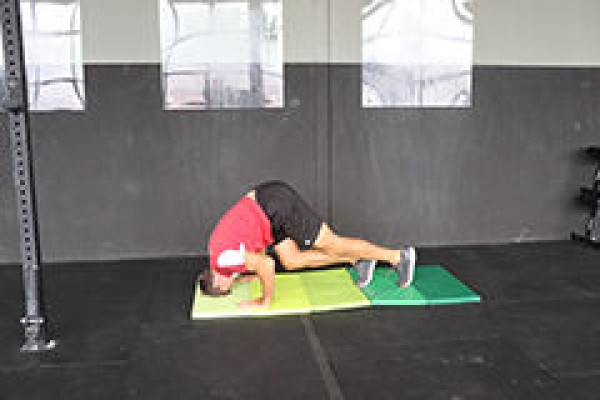
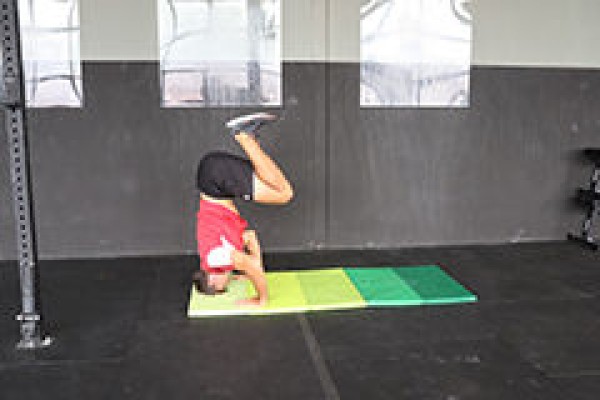
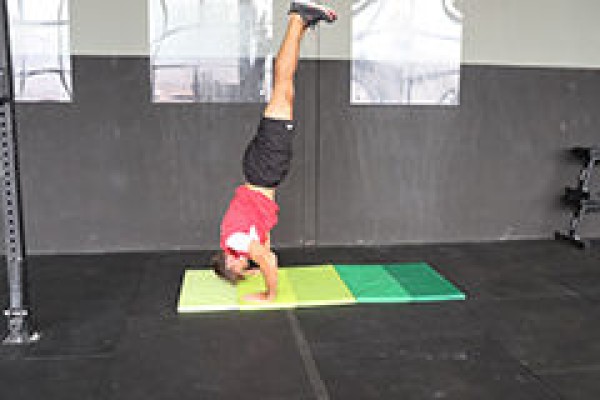
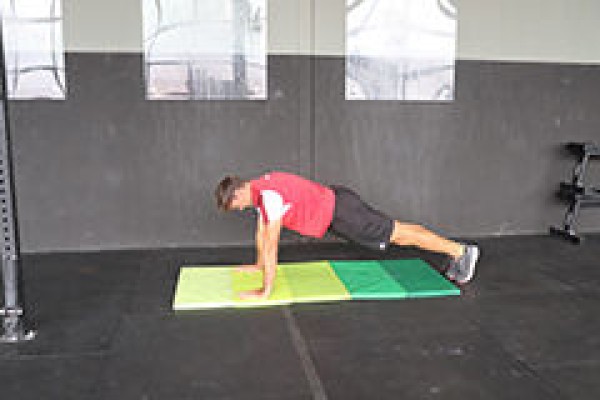
In a kneeling position, the head and bent arms are supported on the floor; a triangle is formed on the floor with the head and both hands. The larger the area of the triangle (i.e. the further apart the corners are), the greater the stability. This basic position is also the starting position for getting into the headstand. Now lift your knees off the floor and stretch your legs so that they are only resting on the tips of your toes (the position roughly corresponds to the letter "V"). Then lift one leg at a time off the floor and bend it (lower legs/soles of the feet pointing upwards, thighs pointing diagonally downwards); now the body is supported only by the head and hands (maintain balance). From this position, the legs are pushed out together at an angle backwards and upwards, while at the same time the arms are stretched, finally landing in the push-up position (high support, face/gaze downwards).
Attention:
When landing in the high support position (push-up position), consciously tense your torso so that you assume the position immediately (without sagging beforehand).
Lighten:
Lift and bend only one leg off the floor, the other leg remains stretched out on the floor (tiptoe position), making it easier to keep your balance. From this position, push yourself into a high support position.
Harden:
Additional weight (on the feet if necessary)
1 soft mat (small)
2 weight cuffs ► to make the exercise more difficult (additional weight)
Circular movement of the arms while standing upright
Power
Individual work

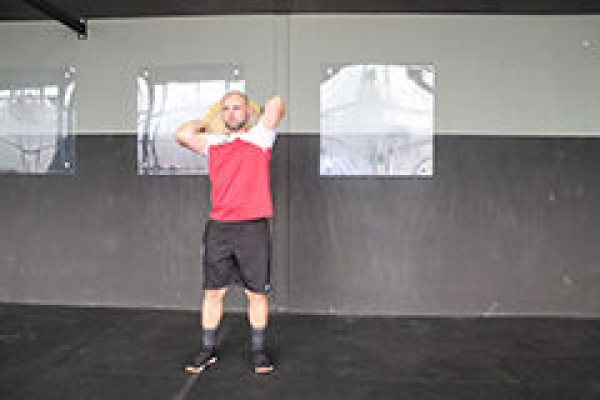
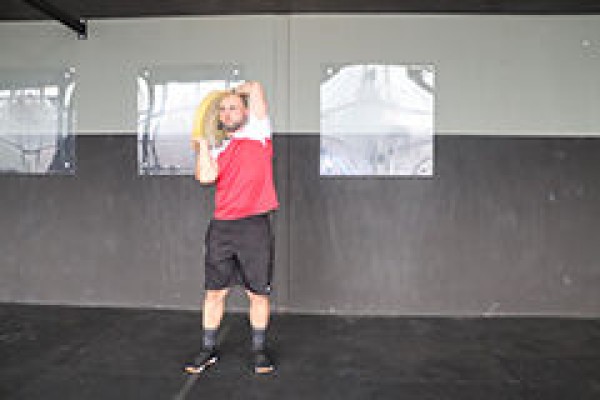
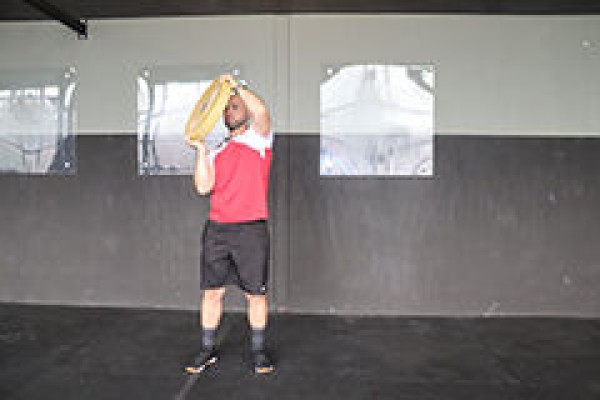
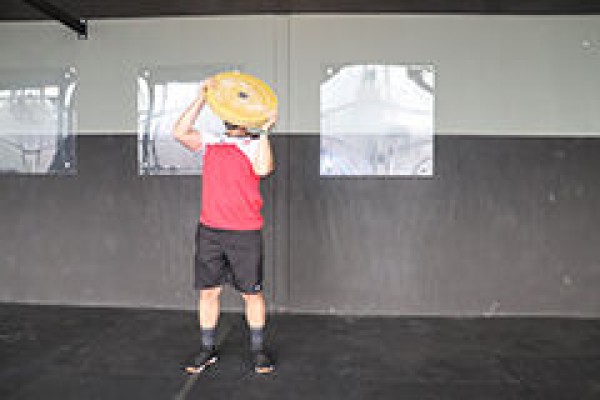
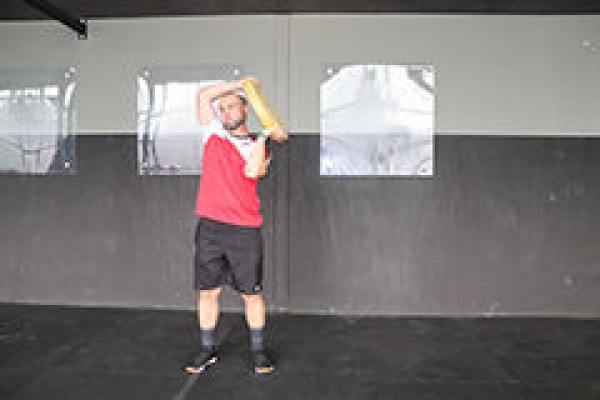
When standing upright, hold a weighted disc in front of your head with your arms bent and move the disc around your head with your arms bent, keeping the rest of your body stable except for your arms. The weight must be kept at head height throughout the exercise. Change the direction of rotation after one or more rounds.
Attention:
Upright posture.
Lighten:
Less weight.
Harden:
More weight.
1 weight disc
Circular movement of the arms in push-up position
Power
Individual work
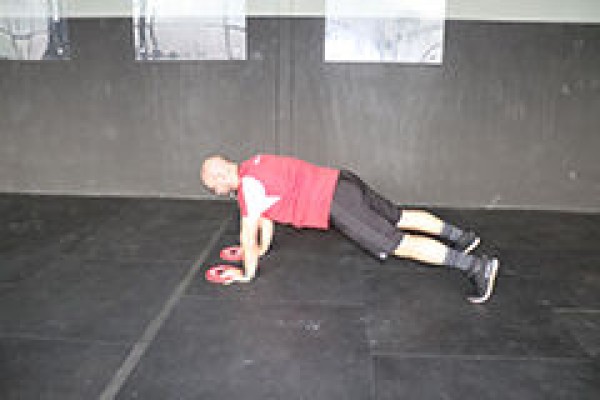
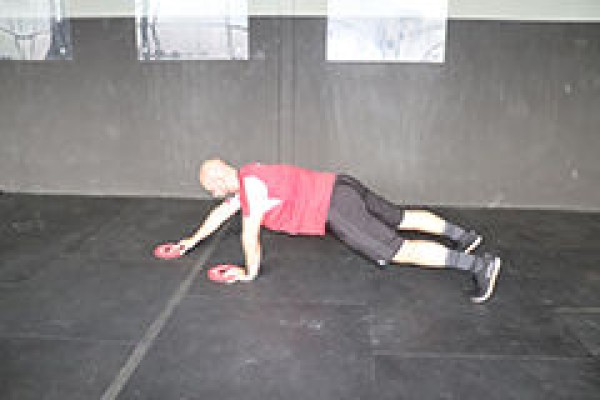

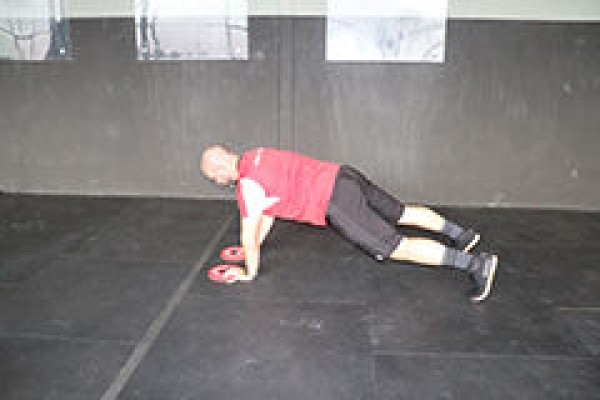
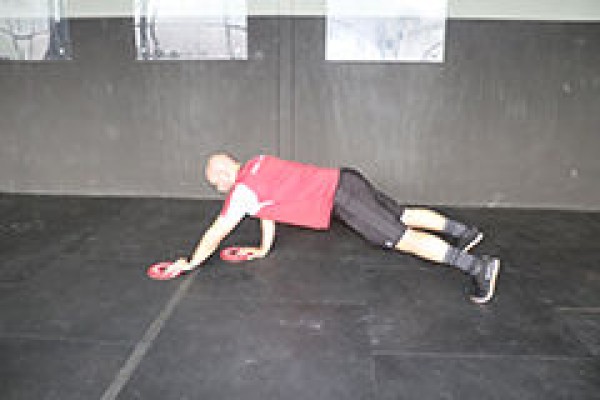
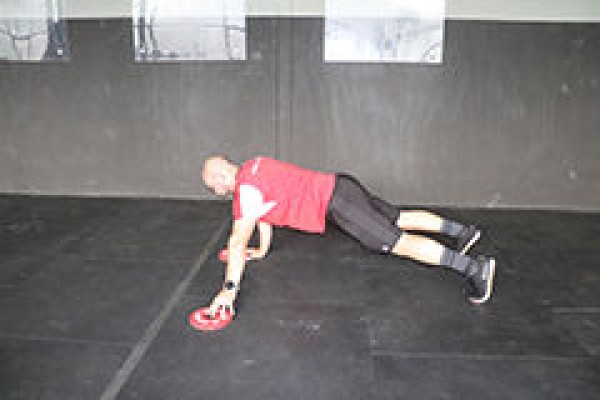
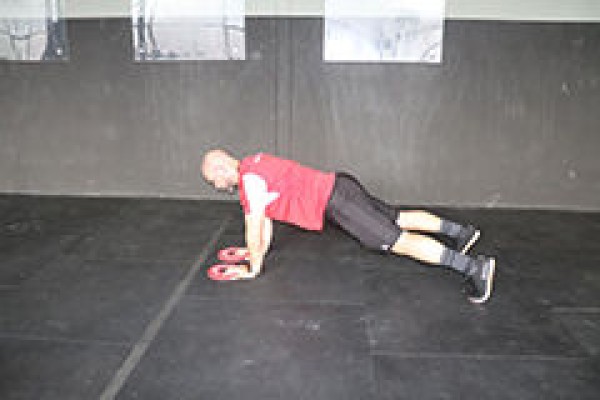
Push-up position (high support, face/gaze downwards) with legs slightly straddling and arms supported on two small weight discs. Slide one arm including the disc forwards along the floor as an extension of the body, then move the outstretched arm to the side (90 degree angle to the body) and return to the starting position (the movement corresponds to drawing a quarter circle, so to speak). Back in the push-up position, perform the same exercise with the other arm/disc.
Attention:
Head, torso, hips and knees form a line (do not let your buttocks sag, tighten your stomach).
Lighten:
Just hold the basic position (push-up position); reduce the range of motion of the playing arm or only move it forwards and back to the starting position.
Harden:
Additional weight (on the back and/or arms).
2 weight discs (small)
1 weight vest/weight disc/sandbag ► Make the exercise more difficult (additional weight)
2 weight cuffs ► Make the exercise more difficult (additional weight)
Circular movement of the legs in supine position ► double leg circle
Power
Individual work
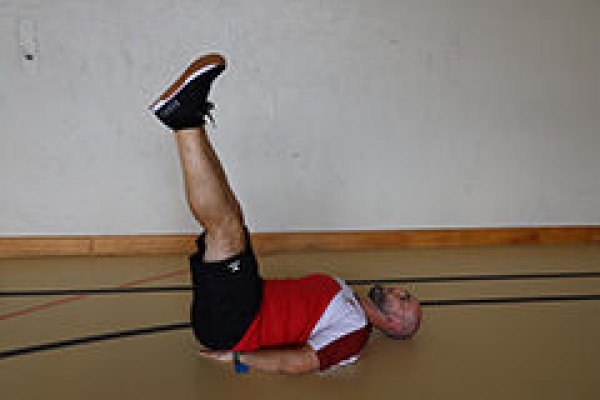

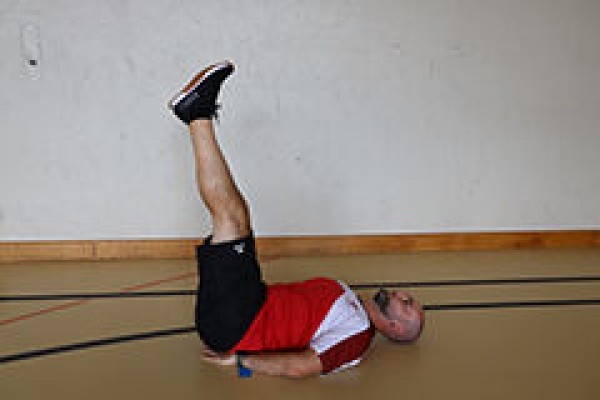
Lie on your back with your arms flat on the floor at your sides or place your hands under your buttocks and your outstretched legs slightly off the floor. Perform circular movements with your legs closed (vary the range of movement and direction).
Attention:
Keep your (lower) back in constant contact with the floor (no hollow back, consciously tense your stomach), do not put your legs down.
Lighten:
Just hold the position (legs stretched out slightly off the floor).
Harden:
Clamp additional weight for the legs/between the legs.
2 weight cuffs/1 (medicine) ball ► Make the exercise more difficult (additional weight)
Pull down the load in supine position ► lying behind the neck pull down
Power
Partner work
1 trainee & 1 helper ► Note change of position
(= double the time required; for lesson planner see Organisation Kraft: Info button Execution)
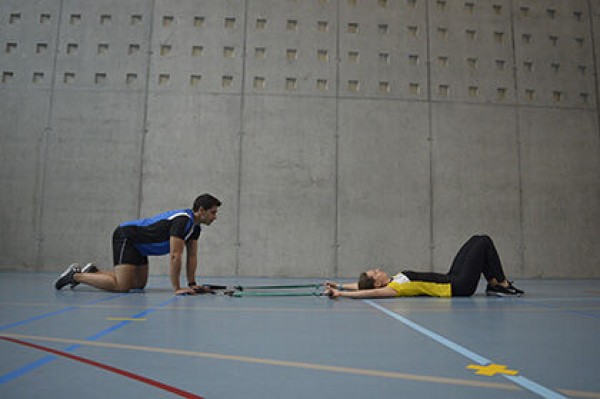
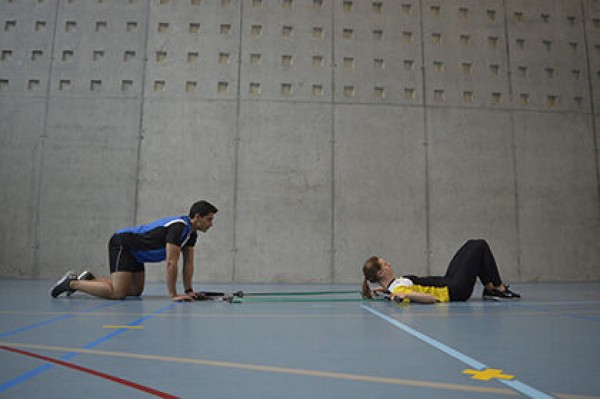
Exerciser: Lie on your back and hold the gymnastics pole above your head with your arms stretched out horizontally (arms parallel to the floor), legs slightly bent and heels up, pull the gymnastics pole into your neck against the resistance of the elasticated straps, raising your head slightly (looking towards the ceiling).
Partner: Hold the loops above the gymnastics pole on the floor.
Attention:
The lower part of the back (lumbar spine) remains on the floor throughout the exercise.
Lighten:
Select less strong elastic bands; roll up the elastic bands less or reduce the distance to your partner.
Harden:
Select stronger elastic bands, roll up the elastic bands more or increase the distance to your partner.
1 gymnastic stick with elasticated strap
Running (1000m/1km) ► run
Power
Individual work
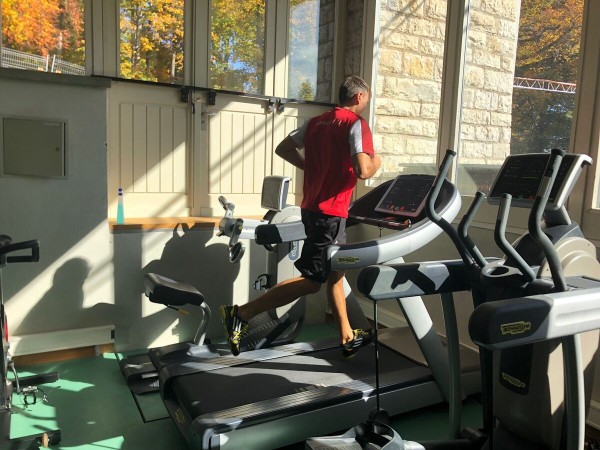
Cover a given distance (1000 m/1 km) by walking/running.
Lighten:
Lower speed.
Harden:
Higher speed.
1 circular track or predetermined route with markings
Running (100m) ► run
Power
Individual work
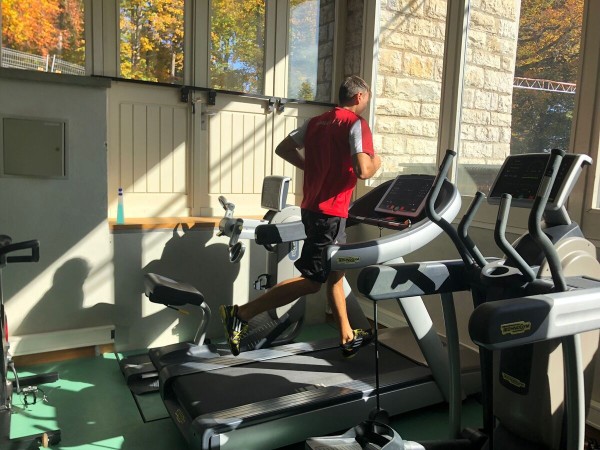
Cover a given distance (100 m) by walking/running.
Lighten:
Lower speed.
Harden:
Higher speed.
2 marking cones/caps/colouring sticks
Running (1600m/1.6km/1 mile) ► run
Power
Individual work
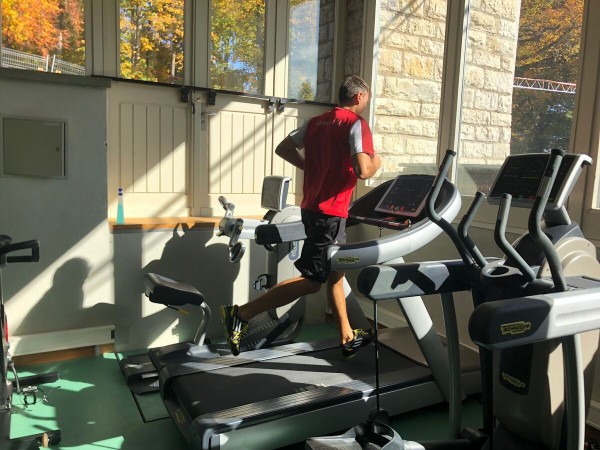
Cover a given distance (1600 m/1.6 km/1 mile) running/racing.
Lighten:
Lower speed.
Harden:
Higher speed.
1 circular track or predefined route with markings
Running (200m) ► run
Power
Individual work

Cover a given distance (200 m) by walking/running.
Lighten:
Lower speed.
Harden:
Higher speed.
2 marking cones/caps/colouring sticks
Running (25-100m) ► run
Power
Individual work
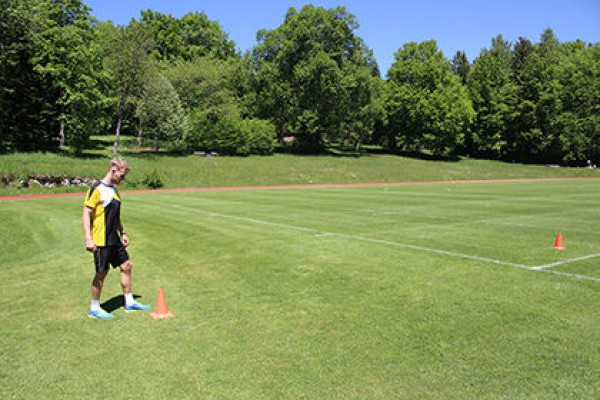
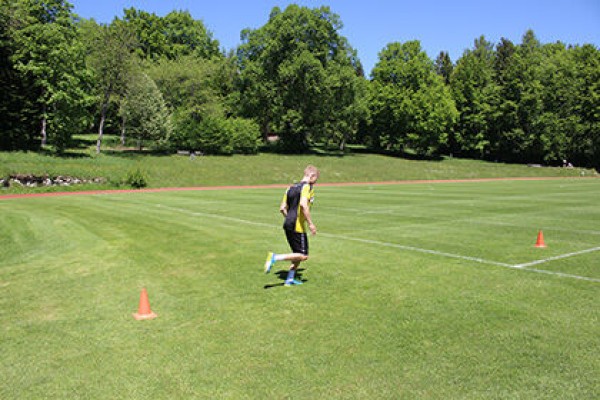
Cover a given distance (between 25-100 metres) by walking/running.
Lighten:
Lower speed.
Harden:
Higher speed.
Variation:
Change gait (e.g. backwards, on all fours, crawling, etc.).
2 marking cones/caps/colouring sticks
Running (300m) ► run
Power
Individual work
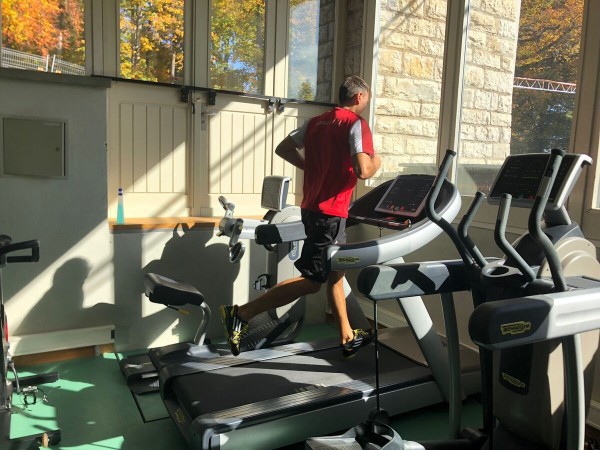
Cover a given distance (300 m) by walking/running.
Lighten:
Lower speed.
Harden:
Higher speed.
1 circular track or predefined route with markings
Running (400m) ► run
Power
Individual work

Cover a given distance (400 m) by walking/running.
Lighten:
Lower speed.
Harden:
Higher speed.
1 circular track or predefined route with markings
Running (600m) ► run
Power
Individual work
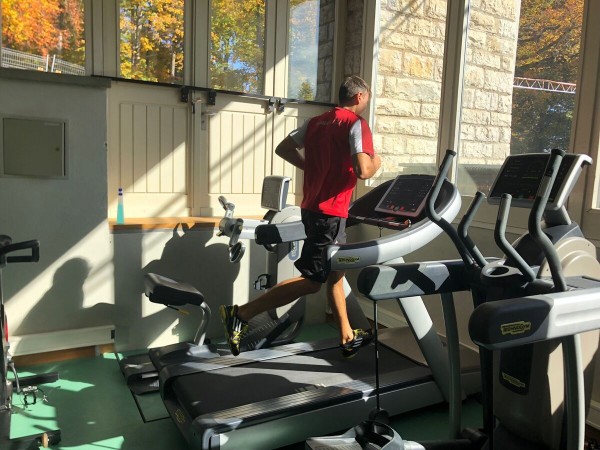
Cover a given distance (600 m) by walking/running.
Lighten:
Lower speed.
Harden:
Higher speed.
1 circular track or predefined route with markings
Running (800m) ► run
Power
Individual work
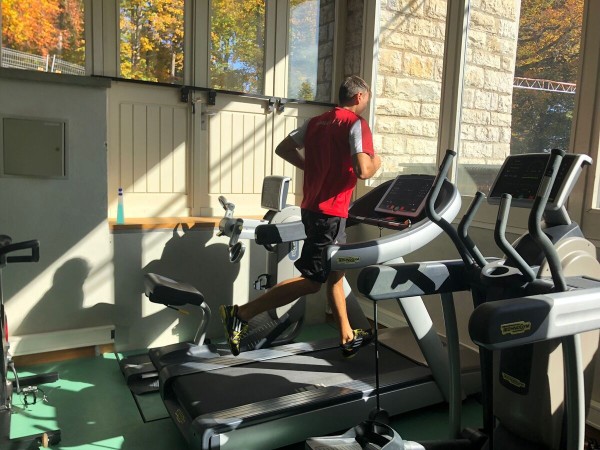
Cover a given distance (800 m) walking/running.
Lighten:
Lower speed.
Harden:
Higher speed.
1 circular track or predefined route with markings
Running (800m) ► run
Power
Individual work

Cover a given distance (800 m) by walking/running.
Lighten:
Lower speed.
Harden:
Higher speed.
1 circular track or predefined route with markings
Running ► run
Power
Individual work
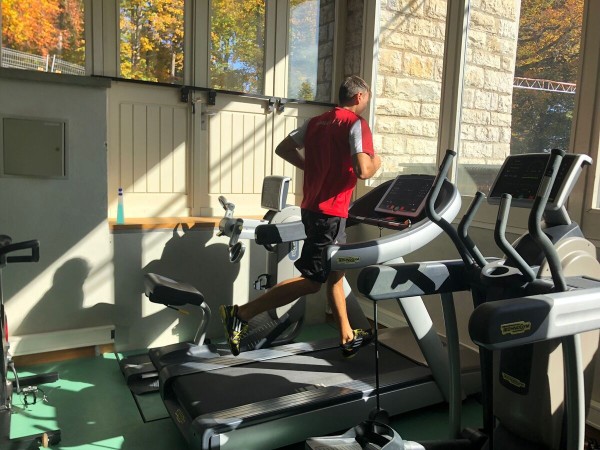
Cover a distance by walking (longer distance) or running (shorter distance).
Lighten:
Lower speed.
Harden:
Higher speed.
No material required
Push up / forearm support ► push up / pillar bridge
Power
Partner work
Exercise both muscle groups ► Note the change of position
(= double the time required; for lesson planner see Organisation Strength: Info button Execution)
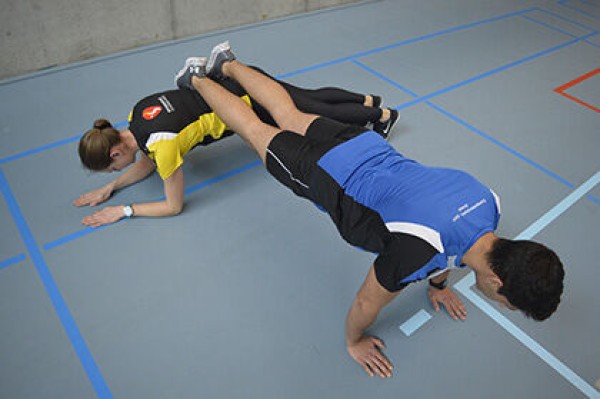

One participant is in the forearm support position, the other participant is in the push-up position to the side of their partner at torso height (body view of the participants corresponds to the letter "T"). The trainee in the push-up position places their feet on their partner's back and lowers their upper body by bending and stretching their arms (push-up), while the trainee in the forearm support maintains a stable position.
Attention:
Tense your core, do not let your pelvis sag (applies to both participants); during the push-ups, bend your elbows approx. 45° from the upper body ("A" shape with the arms), shoulders are fixed and pressed down towards the hips.
Lighten:
Lower the knees (feet vertically in the air); barely bend the arms (lower the upper body less); support the arms on a raised surface.
Harden:
Additional weight (on the back).
1 Raised base (e.g. 1-2 vaulting box elements incl. top section) ► Make the exercise easier (position)
1 Weight vest/weight disc/sandbag ► Make the exercise more difficult (additional weight)